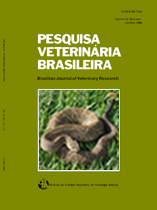 |
|
|
|
Year 2006 - Volume 26, Number 2
|

|
Neoplasias do trato alimentar superior de bovinos associadas ao consumo espontâneo de samambaia (Pteridium aquilinum)
|
ABSTRACT.- Moreira Souto M.A., Kommers G.D., Barros C.S.L., Piazer J.V.M., Rech R.R., Riet-Correa F. & Schild A.L. 2006. [Neoplasms of the upper digestive tract of cattle associated with spontaneous ingestion of bracken fern (Pteridium aquilinum).] Neoplasias do trato alimentar superior de bovinos associadas ao consumo espontâneo de samambaia (Pteridium aquilinum). Pesquisa Veterinária Brasileira 26(2):112-122. Departamento de Patologia, Universidade Federal de Santa Maria, 97105-900 Santa Maria, RS, Brazil. E-mail: glaukommers@yahoo.com
Thirty bovine with neoplasms of the upper digestive tract (UDT) associated with spontaneous ingestion of bracken fern (Pteridium aquilinum) were studied. They were from 27 farms, located in the municipalities of Jaguari (23) and Nova Esperança do Sul (4), Rio Grande do Sul, Brazil. The total cattle population in those farms was 1,090 and large amounts of bracken fern were found in the pastures. Twenty-six of the affected cattle were cows and four were castrated males, 3-13 years of age; most of them were 7-8 years old (46,6%). Clinical signs observed in the affected animals were progressive weight loss, absence of ruminal movements, cough, dysphagia, regurgitation, halitosis, diarrhea, and bloat. Less frequent signs were selective appetite, dyspnea, and salivation. Two bovine died and 28 were submitted to euthanasia in advanced stage of disease and necropsied. The main gross and microscopic alterations were found in identical areas of the UDT. They consisted of papillomas, transforming papillomas, and squamous cell carcinomas (SCCs). Metastases of SCCs to regional lymph nodes and other organs, such as liver and lungs, were also observed (18/30). Twenty-nine bovine had papillomas of various sizes in several areas of the UDT. The digestive papillomatosis ranged from mild (45%), to moderate (38%), to severe (17%). Three developing phases were observed microscopically in the examined papillomas: an early growing phase, a developing phase, and a regressing phase. In 16 cases, there was malignant transformation of papillomas into SCCs. The SCCs were solitary (12/30) or multiple (18/30) and were histologically well, moderately, or poorly differentiated. Grouping the distribution of SCCs of larger extension in the UDT into cranial region (base of the tongue, pharynx/oropharynx, and epiglottis), medial region (esophagus), and caudal region (cardia and rumen), the distribution was cranial in 39%, middle in 16%, and caudal in 45% of the cases. By the same grouping criteria, but considering the total number of times SCCs of varied extensions were diagnosed in the cranial, middle, and caudal regions, the percentages changed to 34%, 26%, and 40%, respectively. The epidemiological and histomorphological evidences found in this study are in agreement with the observations that point out the co-carcinogenesis between bovine papillomavirus type 4 infection and chemicals of bracken fern in the pathogenesis of the SCCs in the UDT of cattle. However, the presence of pre-neoplastic changes and SCCs in situ or in early stages of development, independently of the presence of papillomas, clearly indicates the possibility of development of SCCs from normal epithelium, probably due to the direct action of the chemical carcinogens contained in bracken fern. |
| |
|
|
| |
|
 |